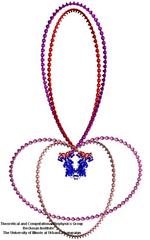Highlights of our Work
2024 | 2023 | 2022 | 2021 | 2020 | 2019 | 2018 | 2017 | 2016 | 2015 | 2014 | 2013 | 2012 | 2011 | 2010 | 2009 | 2008 | 2007 | 2006 | 2005 | 2004 | 2003 | 2002 | 2001

image size:
49.3KB
made with VMD
One of the most fascinating aspects of molecular biology is how
objects of very different sizes are involved in the intricate
biological machinery of living cells. A small protein may bind to DNA
many times larger than itself and fold the DNA into a loop to regulate
nearby genes. Understanding of such processes requires coupling of the
dynamics of an individual protein to the dynamics of a long, looped
DNA double helix. This can be achieved best through a so-called
multi-scale approach that describes the protein motion at atomic
resolution and the larger DNA in a less resolved manner as an elastic
rod, i.e., a physical object behaving much like a twisted garden hose.
Mathematical equations can be devised that capture the behavior of the
DNA "hose" bent into a loop by a bound protein, predicting the
conformation of the DNA as well as the energy that the protein has to
muster to keep the DNA looped (DNA prefers energetically to be
straight). A recent publication
studies in detail mathematically and computationally the elastic rod
model of DNA, taking for a case study the DNA loop folded by the lac
repressor, a celebrated protein regulating the expression of DNA in
E. coli. The study explores how physical characteristics built into the
the elastic rod model influence the energy and conformation of looped
DNA and describes the possible ways of coupling the looped DNA to
all-atom protein simulations of the lac repressor or other regulatory
proteins in order to achieve the
multi-scale description
of a protein-DNA complex.



